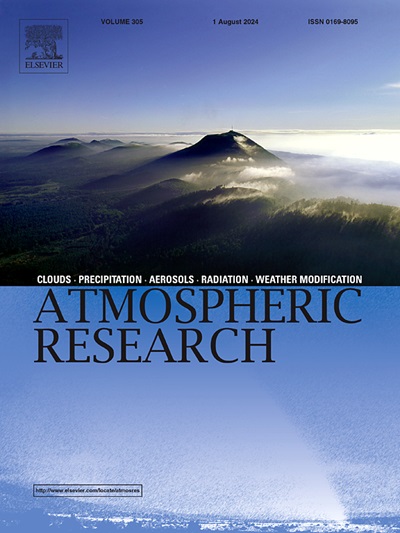深度学习揭示大西洋飓风周围的四种水汽模式:特征及其与飓风强度和降水的关系
IF 4.5
2区 地球科学
Q1 METEOROLOGY & ATMOSPHERIC SCIENCES
引用次数: 0
摘要
湿度在飓风的能量学中起着关键作用。使用卷积自编码器(一种最先进的深度学习空间模式分类方法),我们使用k-means识别了北大西洋飓风周围的四个代表性的总柱水蒸气(twv)模式簇。这四个星团在数量、对称性和面积范围上表现出不同的twv空间分布。集群1具有紧凑、对称和中等湿度模式,我们称之为中等湿度对称。集群2是高湿度对称的,因为这些飓风有丰富的湿度,具有广泛和对称的模式。集群3是低湿度不对称的,因为它代表了最干燥的条件,特别是在西北部。集群4中心附近湿度较高,但表现出西北干燥与东南湿润对比最强烈的格局,因此我们将其标记为高湿度不对称。每个集群的地理和时间分布都有明显的差异,这表明与集群湿度模式相关的动力和热力学环境条件存在差异。此外,飓风的强度、大小和降水特征在四个星团之间有所不同,这些特征与每个星团的湿度和环境条件密切相关。我们的研究应用了一种深度学习方法来对飓风周围的湿度空间模式进行分类,强调了湿度条件在飓风演变中的重要性。本文章由计算机程序翻译,如有差异,请以英文原文为准。
Four moisture patterns surrounding Atlantic hurricanes revealed by deep learning: Their characteristics and relationship with hurricane intensity and precipitation
Moisture plays a key role in the energetics of hurricanes. Using a convolutional autoencoder, a state-of-the-art deep learning approach to spatial pattern classification, with k-means we identified four representative clusters of total column water vapor (TCWV) patterns around North Atlantic hurricanes. These four clusters exhibit distinct spatial distributions of TCWV in terms of amount, symmetry, and areal extent. Cluster 1 has a compact, symmetric, and moderate moisture pattern which we refer to as medium moisture symmetrical. Cluster 2 is high moisture symmetrical as these hurricanes have an abundance of moisture with a widespread and symmetric pattern. Cluster 3 is low moisture asymmetrical as it represents the driest conditions especially in the northwest. Cluster 4 has high moisture near the center but exhibits a pattern with the strongest contrast between dryness in the northwest and wetness in the southeast, thus we label it high moisture asymmetrical. Each cluster has distinct geographical and temporal distributions, indicating differences in dynamic and thermodynamic environmental conditions associated with each cluster's moisture pattern. Additionally, hurricane intensity, size, and precipitation features vary among the four clusters, characteristics which are closely associated with the moisture and environmental conditions of each cluster. Our study's application of a deep learning method in classifying spatial patterns of moisture around hurricanes highlights the importance of moisture conditions in a hurricane's evolution.
求助全文
通过发布文献求助,成功后即可免费获取论文全文。
去求助
来源期刊

Atmospheric Research
地学-气象与大气科学
CiteScore
9.40
自引率
10.90%
发文量
460
审稿时长
47 days
期刊介绍:
The journal publishes scientific papers (research papers, review articles, letters and notes) dealing with the part of the atmosphere where meteorological events occur. Attention is given to all processes extending from the earth surface to the tropopause, but special emphasis continues to be devoted to the physics of clouds, mesoscale meteorology and air pollution, i.e. atmospheric aerosols; microphysical processes; cloud dynamics and thermodynamics; numerical simulation, climatology, climate change and weather modification.
 求助内容:
求助内容: 应助结果提醒方式:
应助结果提醒方式:


